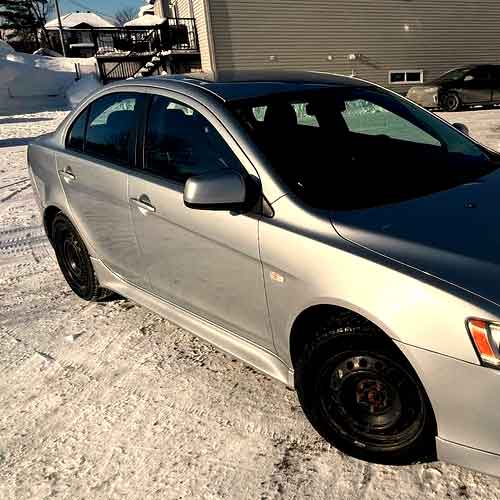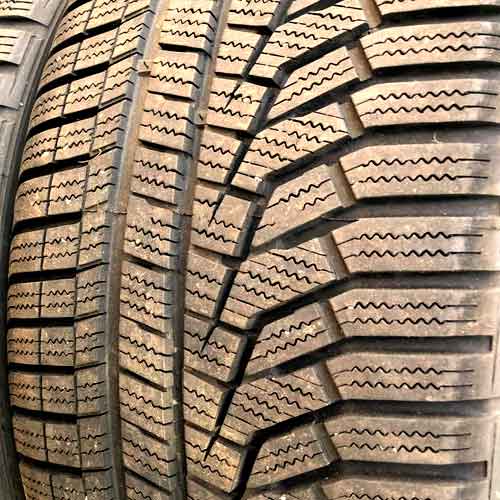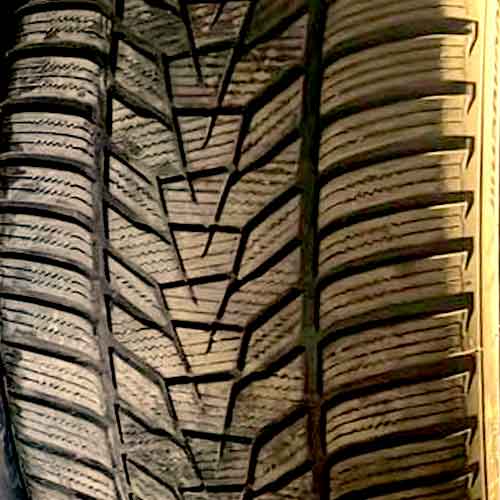The Hankook Winter Icept EVO2, celebrated for its impressive winter handling, and the Hankook Winter Icept Evo3, acclaimed for its excellent traction, are set to go head-to-head. So it’s time to find a better pick, out of them, for you!

Table of Contents
Sizes Takeaway
The Hankook Winter Icept EVO2 comes in 14 to 18 inches with following.
- Speed ratings: V only.
- Load ratings: SL and XL.
- Tread depth: 10.5/32″.
- Weight: 15 to 30 lbs.
On the other side, the Hankook Winter Icept EVO3 comes in 18 and 21 inches only, with following.
- Speed ratings: V on all.
- Load range: SL/XL only.
- Tread depth: 10.5/32″ on all.
- Weight: 14 to 33 lbs.
Tread Pattern
Hankook Winter Icept EVO2 features an asymmetrical tread pattern. Let’s look at its design features in details, (it really helps with the tire selection, trust me).

So to understand the tread of this tire, its best you consider the 4 ribs on it.
The one on the right (most), is seen with elongated, very laterally oriented lugs, with wave-like siping on them.
These lugs provide amazing handling, as they are kept firm, by reinforced foundations underneath them.
Moreover, helping to that are the connectors in between these lugs, and the ones on the following rib.
Speaking of which, this rib is the most aggressive with sharp in-groove biters/notches, and multi-angled interlocking sipes.
Though the other two ribs are very less aggressive, and more streamlined.
The middle (almost) rib features lugs with squared-shaped designs. And here you can see in-groove notches and of course similar siping, like seen elsewhere.
And yes, sames the case with the shoulder rib, though lugs are elongated there.
Moving on towards the Hankook Winter Icept EVO3…

This tire features a very aggressive directional tread pattern, with sharp lugs having tons of features.
In the middle most, the lugs have very edgy in-groove notches, and (almost) rectilinear full depth siping.
And the surrounding lugs are elongated and have interlocking (wave-like) siping, besides having chamfered edges towards their outer area.
Moreover, all these lugs are separated form the shoulders with the help of wide, and prominent, longitudinal grooves.
Speaking of which, the shoulders are the most elongated, and have a mixture of interlocking and rectilinear siping pattern.
But other than that, they don’t carry any other features.
Tread Longevity
When it comes to tread longevity, both tires exhibit commendable effectiveness. However, they achieve this in different ways.
The Hankook Winter Icept EVO3 gains an advantage in weight. Its lighter structure exerts less pressure on the lugs as the tire rolls, resulting in an extended lifespan.
But its overall tread life (on average), is very similar to its counterpart, the Evo 3, which benefits from having larger tread depth, allowing it to take a longer time to wear down to the legal limit of 2/32″.
So you can say, both tires are winners in this section.
Ice Performance
In icy conditions, the Hankook Winter Icept EVO3 clearly outshines its competitor. It incorporates advanced design features such as unique biters scattered across the tread and enhanced with snow vices. These innovations enable the tire to deliver slightly better overall traction on icy surfaces.
The EVO3’s innovative design, complemented by multi-angle siping and snow vices, facilitates faster braking and improved handling efficacy on various types of snowy terrain. On the other hand, the Hankook Winter Icept EVO2, despite having multi-angle biters, falls short in comparison. Its wider biters hinder their efficiency on compacted ice, where narrower and more aggressive siping is required.
Consequently, the design of the Hankook Winter Icept EVO2 is better suited for heavier vehicles like SUVs due to its broader tread voids.
Winner: Hankook Winter Icept EVO3 exhibits superior ice performance.
Wet Traction
Wet traction is primarily influenced by two key components: tread design and rubber compound. These factors play a crucial role in determining a tire’s ability to clear water away from the sipes and grooves.
The grooves in the tire design are primarily responsible for water clearance, providing resistance to hydroplaning. On the other hand, the sipes contribute to wet grip by clearing water at a micro level. They effectively draw water particles into their slits.
Let’s delve into these dimensions in more detail.
Wet Grip
Both tires feature ample siping and flexible tread rubber, but the Hankook Winter Icept EVO3 gains an edge in terms of wet handling. However, both tires perform equally well in terms of wet directional grip.
The Hankook Winter Icept EVO3’s superiority in wet handling can be attributed to its superior water expulsion capabilities from the shoulders. This is made possible by the presence of multi-angle sipes and snow vices facing in both lateral and longitudinal directions on the tire’s tread. These design elements ensure a relatively more effective grip during cornering, reducing overall slippage.
In contrast, the Hankook Winter Icept EVO2’s shoulder sipes are oriented only laterally, resulting in somewhat underwhelming handling performance during testing.
Winner: Hankook Winter Icept EVO3 demonstrates better wet grip.
Hydroplaning
Hydroplaning, a condition where water prevents the tread from making proper contact with the road, poses a significant safety concern. In this regard, the Hankook Winter Icept EVO2 outperforms its competitor. Its wider grooves effectively disperse water in all directions, minimizing the risk of hydroplaning.
On the other hand, the Hankook Winter Icept EVO3, lacking interconnected lugs and featuring more closed-up lugs positioned longitudinally, restricts water movement, particularly laterally.
Winner: Hankook Winter Icept EVO2 excels in hydroplaning resistance.
Snow Performance
When it comes to snow-covered terrains, the Hankook Winter Icept EVO2 outperforms nearly all other winter tires, including the Hankook Winter Icept EVO3. This superiority stems from the tire’s broader grooves, which enhance its ability to make better contact with the snow.
The Hankook Winter Icept EVO2’s multiple triangular lugs spread across the tread provide excellent snow-clinging grooves, resulting in superior traction in fluffy snow conditions. Snow sticks better to snow, and the tire’s design facilitates this interaction, providing enhanced snow-holding abilities.
In contrast, the Hankook Winter Icept EVO3’s relatively closed pattern struggles to accumulate as much snow, hampering its traction.
Winner: Hankook Winter Icept EVO2 exhibits superior snow performance.
Dry Traction
Dry traction, a vital performance measure for any tire, depends on the extent of rubber in contact with the road surface. Two key factors play a role in achieving this: directional grip and lateral traction.
Let’s discuss them individually.
Directional Grip
Efficiency in directional grip primarily depends on the central region of the tread. This is because, while cruising on straight highways, the majority of the tire’s load is concentrated in this area.
The Hankook Winter Icept EVO3 excels in this aspect due to its interlocking central lugs, maximizing contact with the road surface. This design enables shorter braking distances when compared to the Hankook Winter Icept EVO2, which falls short due to its wider grooves and less streamlined structure.
Winner: Hankook Winter Icept EVO3 demonstrates better directional grip.
Handling
The quality of tire handling is significantly influenced by the tire’s shoulder design and overall weight. When cornering, the weight load shifts towards the edges of the tread due to inertia.
The Hankook Winter Icept EVO3 emerges as the winner in this aspect, thanks to two primary factors. Firstly, its more compact shoulder blocks enhance rubber-to-road contact during cornering.
Secondly, the tire’s lighter structure, combined with a shallower tread depth, minimizes lug movement or block bending, providing balanced understeering and oversteering capabilities.
In contrast, the Hankook Winter Icept EVO2, with its wider grooves and larger tread depth, experiences more lug movement during cornering, diminishing steering feedback.
Winner: Hankook Winter Icept EVO3 exhibits superior handling.
Comfort Levels
The degree of comfort provided by a tire largely depends on its noise generation and its ability to dampen vibrations. These characteristics are primarily governed by the tire’s construction. Let’s examine each of these elements.
Tread Noise
Tread noise occurs when air particles collide with the tread walls of the tire. In general, larger tread voids tend to generate more noise.
When comparing the Hankook Winter Icept EVO3 and its counterpart, the former emerges as the quieter option.
This can be attributed to its densely packed shoulder lugs, serving as the primary entry point for air.
Additionally, its crowded central lug design allows less room for air particles to move around. These design attributes not only reduce noise generation at the source but also work in conjunction with the tire’s superior pitch sequencing to further dampen any residual noise.
Winner: Hankook Winter Icept EVO3 offers a quieter ride.
On-Road Vibration
While the Hankook Winter Icept EVO2 may generate more noise, it excels in mitigating road vibrations, providing superior impact comfort.
This is due to its more absorbent tread rubber and greater tread depth, which provide a thicker buffer layer between the tire and any road irregularities.
Winner: Hankook Winter Icept EVO2 offers better on-road vibration dampening.
Summing Up
In snow-covered conditions, the Hankook Winter Icept EVO2 stands out due to its unique tread design and a greater number of tread voids, ensuring superior snow grip and clearance.
On the other hand, when traversing icy terrains, the Hankook Winter Icept EVO3 takes the lead. It utilizes intricate biting edges, angled slits, and multi-angled sipes to enhance overall traction and handling capabilities.
Both tires demonstrate excellent grip on wet and dry surfaces, with the Hankook Winter Icept EVO2 excelling in hydroplaning resistance.
Considering all factors, the Hankook Winter Icept EVO3 slightly edges ahead due to its enhanced fuel economy, extended tread life, and quieter operation.